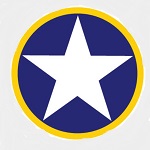Hobby Master HA8907 USN Grumman F4F-4 Wildcat Fighter - Lt. Commander John Raby, VF-9, USS Ranger (CV-4), November 1942 (1:48 Scale)
"Skipper, it really worked. I couldn't make any attack without seeing the nose of one of your airplanes pointed at me."
- Ensign Edward "Butch" O'Hare discussing the newly-developed "Thach Weave" maneuver with Lt. Commander John Thach
 The Grumman F4F Wildcat was the standard carrier-based fighter of the United States Navy for the first year and a half of World War II. An improved version built by General Motors (the General Motors FM Wildcat) remained in service throughout the war, on escort carriers where newer, larger and heavier fighters could not be used.
The Grumman F4F Wildcat was the standard carrier-based fighter of the United States Navy for the first year and a half of World War II. An improved version built by General Motors (the General Motors FM Wildcat) remained in service throughout the war, on escort carriers where newer, larger and heavier fighters could not be used.
The Wildcat was outperformed by the Mitsubishi Zero, its major opponent in the Pacific war, but held its own by absorbing far more damage and wielding more firepower. With heavy armor and self-sealing fuel tanks, the Grumman airframe could survive far more than its lightweight, unarmored Japanese rival.
The original Grumman F4F-1 design was a biplane, which when proving inferior to rival designs was recast as the monoplane F4F-2. This was still not competitive with the Brewster F2A Buffalo which won initial US Navy orders, but when the F4F was fitted with a more powerful engine, the Pratt & Whitney Twin Wasp, it showed its true merits and became the F4F-3. US Navy orders followed as did some (with Wright Cyclone engines) from France; these ended up with the Royal Navy's Fleet Air Arm after the fall of France. In British service initially these were known as the Martlet I, but not all Martlets would be to the exact same specifications as US Navy aircraft. The F4F-3A would enter service as the Martlet III(B), the FM-1 as the Martlet V, and the FM-2 as the Martlet VI. The name Wildcat was still commonly used for these aircraft in spite of the official name change.
A new version, the F4F-4, entered service in 1942 with six guns and folding wings, allowing more to be crammed on a carrier; this was the definitive version and the one that saw the most combat service in the early war years including the Battle of Midway.
Grumman production ceased in early 1943 to make way for the newer F6F Hellcat, but General Motors continued producing them for both US Navy and Fleet Air Arm use, as larger fighters such as the Hellcat and the Vought F4U Corsair were too large for use on escort carriers. At first they produced the identical FM-1 model but then switched to the improved FM-2 (based on Grumman's F4F-8 prototype) with a more powerful engine and a taller tail to cope with the torque. In all, 7,251 Wildcats were built.
All versions of the Wildcat used hand-cranked landing gear with a relatively narrow track, making landing accidents where the landing gear were not fully locked into place distressingly common.
Pictured here is a 1:48 scale USN Grumman F4F-4 Wildcat fighter that was piloted by Lt. Commander John Raby, who was attached to VF-9, then embarked upon the USS Ranger (CV-4), then participating in Operation Torch in November 1942.
Now in stock!
Dimensions:
Wingspan: 9-1/2-inches
Length: 7-1/4-inches
Release Date: September 2022
Historical Account: "Enter the Americans" - Operation Torch (initially called Operation Gymnast) was the British-United States invasion of French North Africa during the North African Campaign of the Second World War which started on November 8th, 1942. It is the first major operation that US troops undertook in the European / North African theatre of World War II.
The Soviet Union had pressed the US and British to start operations in Europe and open a second front to reduce the pressure of German forces on the Soviet troops. While US commanders favored Operation Sledgehammer, landing in Occupied Europe as soon as possible, British commanders believed that such a course was likely to end in disaster. Landings in French North Africa were instead proposed. On July 28th, the Axis Afrika Korps, under General Erwin Rommel, captured Mersa Matruh, in Egypt, only 140 miles (230 km) from Alexandria. Landings to the west would reduce pressure on Allied forces in Egypt. They would also secure Allied naval control of the south-west Mediterranean, and enable an invasion of Southern Europe later in 1943. U.S. President, Roosevelt, suspected that landings in north-west Africa would rule out an invasion of Europe in 1943, but agreed to support British Prime Minister Winston Churchill.
Senior US commanders remained strongly opposed to the landings. After the Western Allies' Combined Chiefs of Staff (CCS) met in Washington on July 30th, General George Marshall and Admiral Ernest King declined to approve the plan. When Roosevelt was told of this, he was furious, called Marshall and King to the White House, and gave a direct order that Torch was to have precedence over other operations and was to take place at the earliest possible date. This was one of only two direct orders he gave to military commanders during the war. (The other was in March 1943, when Roosevelt ordered King to transfer 60 B-24 Liberators from the Pacific to the Atlantic, to combat U-Boats.)


